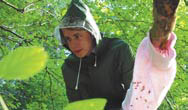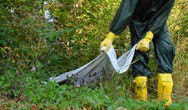| Tick Patrol HLFS Ursprung 2006 |
|
| Home | |
| Abstract | |
| Motivation | |
| Ticks | |
| The Hunt | |
| Laboratory Analysis | |
| Assignment | |
| Video | |
| Bibliography | |
| Team | |
| Imprint | |

![]()
 |
|
| Close encounter of the first kind. |
 |
|
| Ticks are color blind. They aren’t even scared off by these boots. |
The Hunt
There are several different methods of catching ticks. We decided to use the “Flagging” method. This method requires a soft white sheet, on which the smell of body odor is lingering, since the ticks are attracted by the smell of their hosts. For this purpose we put the sheet on our beds for a couple of nights and slept on them. Another option would have been to use the said sheets to clean off certain animals such as dogs. We made sure that the sheets weren’t too smooth, so that the ticks would be able to cling to them.
The work we did in the woods was organised into teams. In each team there was a catcher, a plotter, a runner and a cleaner.
The job of the plotter was to mark each tick exactly on the map, since we wanted to combine this data with the laboratory results to find out exactly which areas of the woods around our school were at risk. We developed a system of plotting for this purpose. The runner was to run to the school with the ticks in order to put them in the freezer. It was very important that the ticks be frozen as quickly as possible in order to conserve the sensitive genetic material of the TBE-viruses (RNA). After all the captured ticks had been frozen, our teacher brought them to the university in order to freeze them there at a temperature of minus 70 degrees Celsius.
There were a few actions that we had to take in order to avoid putting ourselves in danger of being infected during the process of catching the ticks: We all had to receive a vaccination against the TBE virus. In order to further assure that we were not putting ourselves at risk we had each one of our vaccinations confirmed for effectiveness. For this purpose we visited Dr. Richter in his lab, where he performed a vaccine titer test free of charge for each member of our team. Proof of vaccination is very important, since our own results showed, that the vaccination alone does not mean that one can be 100% sure of really being protected. The results for one of the students in the team showed that the vaccine was not effective for him and that he therefore was not protected from contracting TBE.
During the act of „flagging” the catchers had to wear the protective clothing provided to them, which consisted of rubber boots and gloves, raintrousers and a rain coat. The spaces between the trousers and the boots as well as between the sleeves and the gloves were rapped in tape to prevent the ticks from penetrating.
The ticks were removed carefully with forceps from the sheets and killed in 70 proof alcohol.
The protective clothing was cleaned in order to assure that no ticks had gone unnoticed. This was done after the day of catching the ticks, which had been a lot of fun for us. When we got home we showered and made sure that we didn’t have any ticks on our bodies. During our forays through the woods we were able to catch 280 ticks (larva, nymphs and adults).